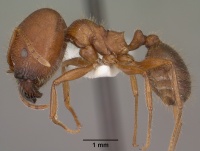Pheidole obtusospinosa
| Pheidole obtusospinosa | |
|---|---|

| |
| Scientific classification | |
| Kingdom: | Animalia |
| Phylum: | Arthropoda |
| Class: | Insecta |
| Order: | Hymenoptera |
| Family: | Formicidae |
| Subfamily: | Myrmicinae |
| Tribe: | Attini |
| Genus: | Pheidole |
| Species: | P. obtusospinosa |
| Binomial name | |
| Pheidole obtusospinosa Pergande, 1896 | |
| Synonyms | |
| |
Stefan Cover (unpublished field notes), who has collected obtusospinosa many times in southern Arizona, has found it consistently in woodland, variously composed of different combinations of pine, oak, and juniper. It typically nests under rocks, although Cover found one colony beneath a cow pat and another 2.5 m from the ground in the dead branch of a standing oak tree (Quercus arizonica). Creighton (1958) reports that colonies are much smaller than those of the now junior synonym Pheidole vasliti hirtula, and that in southern Arizona nuptial flights occur in early July. Creighton (1958, under the name P. vasliti hirtula) reports that mature colonies are very large, with numerous majors, and occasionally dominate the immediate surrounding area to the exclusion of other ant species. Winged reproductives are found in the nests from April to at least September, and nuptial flights evidently occur in late August into early September. According to Barry Pullen, the size variation of the workers is continuous, but with sharp modes marking the minor, major, and supermajor castes. (Wilson 2003)
Identification
This is a polymorphic species, which has the usual minors, intermediate sized workers (which look like major workers of other species) and very large major workers. The scape is flattened at the base, but the flattened area is not as wide as the width of the scape near the apex. It extends about 2/3 the length of the head in the largest workers, but may extend nearly to the posterior lateral lobes in the smallest majors. The entire dorsal surface of the head is sculptured, with granulose sculpture on the front faces of the posterior lateral lobes. The entire dorsum of the head is dull. The mesonotum projects above the level of the pronotum and propodeum. The dorsal surface of the gaster is finely punctate. (Mackay and Mackay 2002)
See the description in the nomenclature section.
Keys including this Species
Distribution
Known from the mountains of southern Arizona at 300–1900 m, New Mexico (very common in Clanton Draw in the Coronado National Forest, Hidalgo Co.), and from Nayarit to Nuevo Leon in Mexico. (Wilson 2003)
According to Creighton (1958), who studied the junior synonym P. vasliti hirtula closely, the species occurs between 1070 and 2310 m, with most colonies concentrated at 1500–2100 m, from northern Chihuahua southward through Coahuila, Nuevo León, San Luis Potosí and Zacatecas to Hidalgo, Querétaro, and Jalisco. Barry E. Pullen (personal communication) reports the species as common in the suburbs of Mexico City. (Wilson 2003)
Latitudinal Distribution Pattern
Latitudinal Range: 30.13833333° to 16.33671667°.
| North Temperate |
North Subtropical |
Tropical | South Subtropical |
South Temperate |
- Source: AntMaps
Distribution based on Regional Taxon Lists
Nearctic Region: United States.
Neotropical Region: Mexico (type locality).
Distribution based on AntMaps
Distribution based on AntWeb specimens
Check data from AntWeb
Countries Occupied
| Number of countries occupied by this species based on AntWiki Regional Taxon Lists. In general, fewer countries occupied indicates a narrower range, while more countries indicates a more widespread species. |
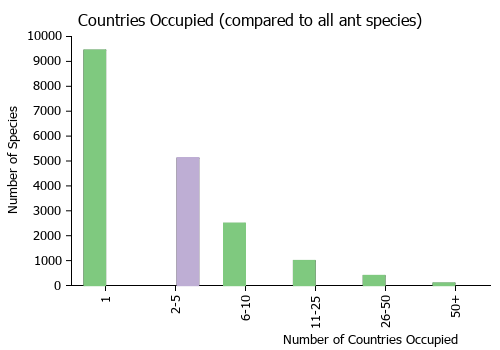
|
Estimated Abundance
| Relative abundance based on number of AntMaps records per species (this species within the purple bar). Fewer records (to the left) indicates a less abundant/encountered species while more records (to the right) indicates more abundant/encountered species. |

|
Habitat
Creosotebush scrub, grasslands, oak-pinyon-pine forests, pinyon-juniper communities, Chihuahua pine, up to 2100 m elevation. (Mackay and Mackay 2002)
Biology
Mackay and Mackay (2002) - This species nests under stones, often the largest stones in an area, or nests in the soil with several separate entrances. It is common in sandy soils, including dunes, but also occurs in areas of rocky loam. Brood is found in nests in March. They are preyed on by Neivamyrmex leonardi, and make no attempt to defend the nest and only escape and rescue brood. Foragers are both diurnal and nocturnal, and visit extrafloral nectaries.
Huang (2010) reported how supermajors of this species served an important role in effectively repelling a Neivamyrmex texanus raid. The observed P. obtusospinosa colony nested at the base of a living oak tree and had a triangular-shaped nest entrance (base: ~ 12mm height: ~ 9mm) partially bordered by hard tree bark and the softer soil ground surface. The nest was in an oak, sycamore, and juniper forest in Gardner Canyon in Tucson, Arizona (31º42.56’N and 110º42.58’W; Elevation: 1618 meters). When a raid occurred in the early afternoon, the super majors effectively blocked the nest entrance using their heads. "After failing to penetrate the nest entrance of the P. obtusospinosa colony, some of the army ants turned away and swarmed around the base of the oak tree, possibly trying to find another entrance into the colony. As the number of army ants at the nest entrance dwindled, the P. obtusospinosa super majors broke their head-blockade formation and stormed out of the nest. One group of P. obtusospinosa majors (large and small) attacked the army ants circling around the tree base from behind, while another group attacked the front line of the incoming army ant reinforcements by heading straight into the army ant foraging trail, occasionally dragging their abdomens on the ground. These actions of the second group of P. obtusospinosa majors resulted in the disorientation of army ant reinforcements at the front end of the trail. The major sign of army ant disorientation was their change from moving in an initially straight path to moving in various, random, directions. Without reinforcements, the group of army ants circling around the tree trunk was left behind. As this isolated group of army ants returned their attention toward the original nest entrance, both groups of P. obtusospinosa majors retreated into the nest, and the super majors resumed their head-blockade formation at the entrance. Even after the P. obtusospinosa majors had abandoned the front line of the army ant trail, army ant reinforcements continued to show signs of disorientation. After 30 to 45 min of switching at least three times between the defensive head-blockade formation and the dual offensive attacks, the P. obtusospinosa colony drove away the raiding army ants."
Huang suggested the effectiveness of the super majors in this Pheidole species may an important reason for their existence. It also supports this being a general hypothesis to explain the presence of super majors in other trimorphic Pheidole species, all of which are found in areas where army ants are present.
Brown & Fenner (1998) report this species being raided by the army ant Neivamyrmex nigrescens at Pefia Blanca Lake, AZ, USA.
| X | X | X | |||||||||
| Jan | Feb | Mar | Apr | May | Jun | Jul | Aug | Sep | Oct | Nov | Dec |
Source: Creighton, 1958; Wilson, 2003.
- Check details at Worldwide Ant Nuptial Flights Data, AntNupTracker and AntKeeping.
 Explore: Show all Flight Month data or Search these data. See also a list of all data tables or learn how data is managed.
Explore: Show all Flight Month data or Search these data. See also a list of all data tables or learn how data is managed.
Association with Other Organisms
 Explore: Show all Associate data or Search these data. See also a list of all data tables or learn how data is managed.
Explore: Show all Associate data or Search these data. See also a list of all data tables or learn how data is managed.
- This species is a host for the eucharitid wasp Orasema tolteca (a parasite) (Mann, 1914; Baker et al., 2019; Universal Chalcidoidea Database) (primary host).
- This species is a host for the phorid fly Apocepbalus sp. 29 (a parasite) in Pefia Blanca Lake, AZ, USA (Brown & Fenner, 1998) (as Pheidole subdentata).
- This species is a host for the phorid fly Apocephalus sp. 29 (a parasitoid) (Quevillon, 2018) (encounter mode primary; direct transmission; transmission outside nest).
Castes
Huang (2010) - Minor workers have an extremely narrow size range (head width = 0.5mm to 0.7mm) and are discretely separated from major workers. The major worker head width distribution was bimodal and ranged from 1.1 mm to 2.4 mm with smaller major workers present in colonies approximately three times as frequently as larger major workers. Results of the cluster analysis (assuming two modes) suggested that small majors range from 1.1 mm to 1.7 mm in head width while larger majors range from 1.7 mm to 2.4 mm. Figure 1b shows that there is no major change in overall head shape when comparing small and larger majors, despite an increase in absolute head size.
Worker
Minor
Images from AntWeb
  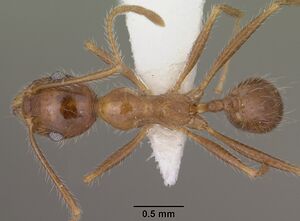 
| |
| Worker. Specimen code casent0102887. Photographer Jen Fogarty, uploaded by California Academy of Sciences. | Owned by CAS, San Francisco, CA, USA. |
   
| |
| Syntype of Pheidole subdentata. Worker. Specimen code castype00647. Photographer April Nobile, uploaded by California Academy of Sciences. | Owned by CAS, San Francisco, CA, USA. |
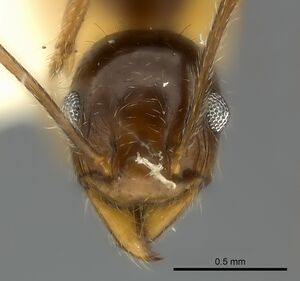 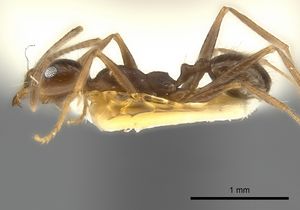  
| |
| Worker. Specimen code casent0217904. Photographer Estella Ortega, uploaded by California Academy of Sciences. | Owned by CAS, San Francisco, CA, USA. |
   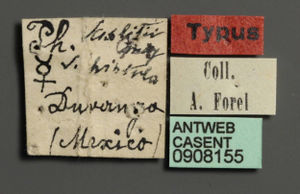
| |
| Syntype of Pheidole hirtula. Worker. Specimen code casent0908155. Photographer Will Ericson, uploaded by California Academy of Sciences. | Owned by MHNG, Geneva, Switzerland. |
   
| |
| Syntype of Pheidole vaslitii acolhua. Worker. Specimen code casent0904367. Photographer Will Ericson, uploaded by California Academy of Sciences. | Owned by MSNG, Genoa, Italy. |
Major
    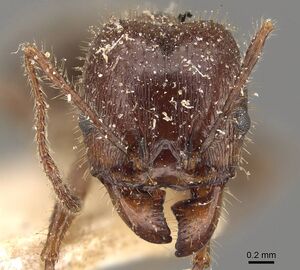       
| |
| . | |
Super Major
Images from AntWeb
   
| |
| Worker (major/soldier). Specimen code castype00649. Photographer April Nobile, uploaded by California Academy of Sciences. | Owned by CAS, San Francisco, CA, USA. |
Nomenclature
The following information is derived from Barry Bolton's Online Catalogue of the Ants of the World.
- obtusospinosa. Pheidole obtusospinosa Pergande, 1896: 889 (s.) MEXICO. Junior synonym of subdentata Pergande: Wheeler, W.M. 1914b: 50; hence first available replacement name for Pheidole subdentata Pergande, 1896: 888 [Junior secondary homonym of Oecophthora subdentata Mayr, 1853a: 145.]; designated by Bolton, 1995b: 326. See also: Wilson, 2003: 587.
- acolhua. Pheidole (Cardiopheidole) vasliti var. acolhua Wheeler, W.M. 1914b: 48 (s.w.q.m.) MEXICO.
- Junior synonym of hirtula: Creighton, 1958: 211.
- Junior synonym of obtusospinosa: Vázquez-Franco & Morrone, 2022: 15.
- arizonica. Pheidole arizonica Santschi, 1911d: 3, fig. (s.) U.S.A. Subspecies of vasliti: Creighton, 1950a: 192. Junior synonym of subdentata: Creighton, 1958: 211; Gregg, 1959: 31.
- hirtula. Pheidole vasliti var. hirtula Forel, 1899c: 65 (s.w.) MEXICO.
- Wheeler, W.M. 1909b: 232 (q.).
- Raised to species and senior synonym of acolhua: Creighton, 1958: 211.
- Junior synonym of obtusospinosa: Vázquez-Franco & Morrone, 2022: 15.
- See also: Wilson, 2003: 578.
- subdentata. Pheidole subdentata Pergande, 1896: 888 (w.) MEXICO. [Junior secondary homonym of subdentata Mayr, above.] Subspecies of vasliti: Wheeler, W.M. 1914b: 50. Revived status as species: Creighton, 1958: 211. Senior synonym of obtusospinosa: Wheeler, W.M. 1914b: 50; of arizonica: Creighton, 1958: 211. Replacement name: obtusospinosa Pergande, 1896: 889; first available replacement name for subdentata Pergande: Bolton, 1995b: 326.
Unless otherwise noted the text for the remainder of this section is reported from the publication that includes the original description.
Description
Pheidole obtusospinosa
From Wilson (2003): DIAGNOSIS A large trimorphic species placed in the pilifera group because of the 2-toothed hypostoma of the major but with other traits conforming to the fallax group. Very close to Pheidole hirtula (now a junior synonym of P. obtusospinosa), distinguished most readily in the supermajor, as illustrated, by the elongate foveae of the rear half of the dorsum of the head, with the interspaces densely foveolate and opaque. The tangled taxonomic history of this species and the true status of Pheidole vaslitii, previously associated with it but now revealed as a junior synonym or sibling species of Pheidole hyatti (q.v.), have been presented by Ward (2000).
MEASUREMENTS (mm) Supermajor: HW 2.50, HL 2.36, SL 1.12, EL 0.26, PW 1.06.
- Major: HW 1.44, HL 1.46, SL 1.12, EL 0.24, PW 0.72.
- Minor: HW 0.62, HL 0.80, SL 0.98, EL 0.16, PW 0.44.
COLOR All castes: yellowish to reddish brown.
Pheidole vasliti hirtula
From Wilson (2003): DIAGNOSIS A large trimorphic species (major, supermajor, minor) placed in the pilifera group because of the 2-toothed hypostoma but with other traits conforming to the fallax group. Very close to Pheidole obtusospinosa, distinguished most readily in the supermajor, as illustrated, by the rounded foveae of the rear half of the dorsum of the head, with the interspaces smooth and shiny. This form is considered by Ward (1999) to be a likely geographic subspecies of obtusopilosa rather than a full species.
MEASUREMENTS (mm) All from near Chapulco, Puebla.
- Supermajor: HW 2.60, HL 2.40, SL 1.18, EL 0.32, PW 1.34.
- Major: HW 1.52, HL 1.60, SL 1.10, EL 0.24, PW 0.82. inor: HW 0.66, HL 0.86, SL 1.04, EL 0.20, PW 0.48.
COLOR: Supermajor, major, and minor: head and appendages light reddish brown to plain medium brown, rest of body medium brown.
Figure. Upper: major, with heads of major (left) and supermajor (right). Lower: minor. ARIZONA: Sunnyside Canyon, Huachuca Mts., Cochise Co. (Stefan Cover). Scale bars = 1 mm.
Figure. Supermajor, head. Scale bars = 1 mm.
Type Material
- Pheidole obtusospinosa: MEXICO. Tepic, Nayarit, col. Eisen and Vaslit, National Museum of Natural History - as reported in Wilson (2003)
- Pheidole vasliti hirtula: MEXICO: km 275, Highway 150 northeast of Chapulco, Puebla. Musee d'Histoire Naturelle Genève - as reported in Wilson (2003)
Etymology
L obtusospinosa, with blunt thorns, referring to the propodeal spines. (Wilson 2003)
Worker Morphology
 Explore: Show all Worker Morphology data or Search these data. See also a list of all data tables or learn how data is managed.
Explore: Show all Worker Morphology data or Search these data. See also a list of all data tables or learn how data is managed.
- Caste: trimorphic
References
- Wilson, E. O. 2003. Pheidole in the New World: A dominant, hyperdiverse ant genus. Harvard University Press, Cambridge, MA. (page 587, fig. major, minor described, senior synonym of arizonica)
- Alatorre-Bracamontes, C.E., Vásquez-Bolaños, M. 2010. Lista comentada de las hormigas (Hymenoptera: Formicidae) del norte de México. Dugesiana 17(1): 9-36.
- Brown, B.V., Fenner, D.H. 1998. Parasitic phorid flies (Diptera: Phoridae) associated with army ants (Hymenoptera: Formicidae: Ecitoninae, Dorylinae) and their conservation biology. Biotropica 30: 482-487.
- Creighton, W. S. 1958. A revisionary study of Pheidole vaslitii Pergande (Hymenoptera: Formicidae). J. New York Entomol. Soc. 65: 203–212.
- Huang M H. 2010. Multi-phase defense by the big-headed ant, Pheidole obtusospinosa, against raiding army ants. Journal of Insect Science 10: 1-10.
- Mackay, W. P. and E. Mackay. 2002. The ants of New Mexico (Hymenoptera: Formicidae). Edwin Mellen Press, Lewiston, NY.
- Mayr, G. 1853b. Einige neue Ameisen. Verh. Zool.-Bot. Ver. Wien 2: 143-150 (page 145, Junior secondary homonym of Oecophthora subdentata)
- Pergande, T. 1896. Mexican Formicidae. Proc. Calif. Acad. Sci. (2) 5: 858-896 (page 889, soldier described, page 888, first available replacement name for Pheidole subdentata)
- Varela-Hernández, F., Medel-Zosayas, B., Martínez-Luque, E.O., Jones, R.W., De la Mora, A. 2020. Biodiversity in central Mexico: Assessment of ants in a convergent region. Southwestern Entomologist 454: 673-686.
- Vázquez-Franco, C.M., Morrone, J.J. 2022. The genus Pheidole (Hymenoptera: Formicidae: Myrmicinae) in Puebla, Mexico. Revista Mexicana de Biodiversidad 93: e933820 (doi:10.22201/ib.20078706e.2022.93.3820).
- Ward, P. S. 2000. On the identity of Pheidole vaslitii Pergande (Hymenoptera: Formicidae), a neglected ant from Baja California. J. Hym. Res. 9(1): 85–98.
- Wheeler, W. M. 1914c. Ants collected by W. M. Mann in the state of Hidalgo, Mexico. J. N. Y. Entomol. Soc. 22: 37-61 (page 50, Junior synonym of subdentata Pergande.)
References based on Global Ant Biodiversity Informatics
- Cover S. P., and R. A. Johnson. 20011. Checklist of Arizona Ants. Downloaded on January 7th at http://www.asu.edu/clas/sirgtools/AZants-2011%20updatev2.pdf
- Creighton W. S. 1958. A revisionary study of Pheidole vasliti Pergande (Hymenoptera: Formicidae). Journal of the New York Entomological Society 65: 203-212.
- Dattilo W. et al. 2019. MEXICO ANTS: incidence and abundance along the Nearctic-Neotropical interface. Ecology https://doi.org/10.1002/ecy.2944
- De la Mora, A., C. J. Murnen, and S. M. Philpott. 2013. Local and landscape drivers of ant-communities in Neotropical coffee landscapes. Biodiversity and Conservation 22: 871-888.
- Fernandes, P.R. XXXX. Los hormigas del suelo en Mexico: Diversidad, distribucion e importancia (Hymenoptera: Formicidae).
- Hernandez, F. Varela and G. Castano-Meneses. 2010. Checklist, Biological Notes and Distribution of Ants (Hymenoptera: Formicidae) from Barranca de Metztitlán Biosphere Reserve, Hidalgo, Mexico. Sociobiology 56(2):397-434
- Johnson R. Personnal Database. Accessed on February 5th 2014 at http://www.asu.edu/clas/sirgtools/resources.htm
- Kempf, W.W. 1972. Catalago abreviado das formigas da regiao Neotropical (Hym. Formicidae) Studia Entomologica 15(1-4).
- Mackay W. P., and E. E. Mackay. 2002. The ants of New Mexico (Hymenoptera: Formicidae). Lewiston, New York: Edwin Mellen Press, 400 pp.
- Pergande, T. 1895. Mexican Formicidae. Proceedings of the California Academy of Sciences Ser. 2 :850-896
- Rivers, A., M. Barbercheck, B. Govaerts, and N. Verhulst. 2016. Conservation agriculture affects arthropod community composition in a rainfed maize-wheat system in central Mexico. Applied Soil Ecology 100: 81-90.
- Varela-Hernandez, F., M. Rocha-Ortega, R. W. Jones, and W. P. Mackay. 2016. Insectos: Hormigas (Formicidae) del estado de Queretaro, Mexico. Pages 397-404 in W. Jones., and V. Serrano-Cardenas, editors. Historia Natural de Queretaro. Universidad Autonoma de Queretaro, Mexico.
- Vieira de Oliveira J. A., D. Martins da Silva, and F. A. Santana. 2014. Ant species diversity in ciliary forest and gallery forest areas in central Brazil. Advances in Entomology 2(1): 24-32.
- Vásquez-Bolaños M. 2011. Lista de especies de hormigas (Hymenoptera: Formicidae) para México. Dugesiana 18: 95-133
- Vasquez-Bolanos M. 2011. Checklist of the ants (Hymenoptera: Formicidae) from Mexico. Dugesiana 18(1): 95-133.
- Vasquez Bolanos M., and J. Escoto Rocha. 2018. Ants (Hymenoptera: Formicidae) of Aguascalientes. Investigacion y Ciencia 24(68): 36-40.
- Ward P. S. 2000. On the identity of Pheidole vaslitii Pergande (Hymenoptera: Formicidae), a neglected ant from Baja California. Journal of Hymenoptera Research 9: 85-98.
- Wheeler W. M. 1914. Ants collected by W. M. Mann in the state of Hidalgo, Mexico. Journal of the New York Entomological Society 22: 37-61.
- Wilson, E.O. 2003. Pheidole in the New World: A Dominant, Hyperdiverse Genus. Harvard University Press
- Pages using DynamicPageList3 parser function
- North subtropical
- Tropical
- FlightMonth
- Eucharitid wasp Associate
- Host of Orasema tolteca
- Phorid fly Associate
- Host of Apocepbalus sp. 29
- Host of Apocephalus sp. 29
- Species
- Extant species
- Formicidae
- Myrmicinae
- Attini
- Pheidole
- Pheidole obtusospinosa
- Myrmicinae species
- Attini species
- Pheidole species
- Ssr
